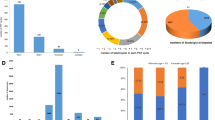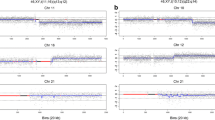Abstract
Purpose
The aim of this study was to determine factors affecting the chromosome imbalance in blastocysts and reproductive outcomes by a comparison between the reciprocal translocation (REC), inversion (INV), and Robertsonian translocation (ROB) carriers.
Methods
Couples with one partner carrying translocation or inversion underwent preimplantation genetic testing for chromosomal structural rearrangement (PGT-SR) cycles, including 215 PGT-SR cycles performed in subsequent 164 frozen-thawed embryo transfer cycles and 61 prenatal diagnoses of fetuses and 59 normal live birth babies. A total of 899 samples were processed by whole-genome amplification followed by next-generation sequencing (NGS). Karyotype and chromosome microarray analyses were used to confirm the PGT results from the amniotic fluid samples.
Results
A total of 843 blastocysts from 124 REC, 21 INV, and 35 ROB carriers were diagnosed by PGT-SR. The percentage of unbalanced blastocysts was significantly higher in REC than in INV and ROB carriers (64.31% vs. 28.05% vs. 37.02%). Stratification analysis of female carrier age and gonadotropin doses showed no significant increase in unbalanced chromosomal abnormalities in the three groups. Also, the different breakpoints in chromosomal arms did not affect the rate of unbalanced chromosomes in the embryos. Logistic regression indicated blastocyst quality as a statistically significant risk factor associated with unbalanced chromosomal abnormalities from translocation carriers (P < 0.001). The source of abnormalities in the three groups showed significant differences such that the abnormalities in REC mostly originated from parental translocation but the abnormalities in INV were mainly de novo variations. 164 blastocysts were transferred, and there were no significant differences in the clinical pregnancy rate and miscarriage rate. A total of 59 healthy babies were born, and there were no significant differences in the gender ratio and birth height, except the birth weight of boys between INV and ROB groups (P = 0.02). The results of amniocentesis revealed that more fetuses have normal chromosomal karyotypes than balanced carriers, particularly in the REC group.
Conclusions
Reciprocal translocation carriers have more risk of unbalanced rearrangement, but embryonic chromosome abnormalities of inversion carriers come mainly from de novo variations. This is the first study specifically comparing three different PGT-SRs using the NGS method and evaluating their reproductive outcomes. Our findings will provide the reciprocal translocation, inversion, and Robertsonian translocation carrier couples with more accurate genetic counseling on the reproductive risk of chromosomal imbalance.



Similar content being viewed by others
References
Weckselblatt B, Rudd MK. Human structural variation: mechanisms of chromosome rearrangements. Trends Genet. 2015;31:587–99.
Van Dyke DL, Weiss L, Roberson JR, Babu VR. The frequency and mutation rate of balanced autosomal rearrangements in man estimated from prenatal genetic studies for advanced maternal age. Am J Hum Genet. 1983;35:301–8.
Iews M, Tan J, Taskin O, Alfaraj S, AbdelHafez FF, Abdellah AH, et al. Does preimplantation genetic diagnosis improve reproductive outcome in couples with recurrent pregnancy loss owing to structural chromosomal rearrangement? A systematic review. Reprod BioMed Online. 2018;36:677–85.
Fischer J, Colls P, Escudero T, Munné S. Preimplantation genetic diagnosis (PGD) improves pregnancy outcome for translocation carriers with a history of recurrent losses. Fertil Steril. 2010;94:283–9.
Otani T, Roche M, Mizuike M, Colls P, Escudero T, Munné S. Preimplantation genetic diagnosis significantly improves the pregnancy outcome of translocation carriers with a history of recurrent miscarriage and unsuccessful pregnancies. Reprod BioMed Online. 2006;13:869–74.
Mateu-Brull E, Rodrigo L, Peinado V, Mercader A, Campos-Galindo I, Bronet F, et al. Interchromosomal effect in carriers of translocations and inversions assessed by preimplantation genetic testing for structural rearrangements (PGT-SR). J Assist Reprod Genet. 2019;36:2547–55.
Zhang S, Lei C, Wu J, Sun H, Zhou J, Zhu S, et al. Analysis of segregation patterns of quadrivalent structures and the effect on genome stability during meiosis in reciprocal translocation carriers. Hum Reprod. 2018;33:757–67.
Xie P, Hu L, Tan Y, Gong F, Zhang S, Xiong B, et al. Retrospective analysis of meiotic segregation pattern and interchromosomal effects in blastocysts from inversion preimplantation genetic testing cycles. Fertil Steril. 2019;112:336–42.
Rubio C, Mercader A, Alamá P, Lizán C, Rodrigo L, Labarta E, et al. Prospective cohort study in high responder oocyte donors using two hormonal stimulation protocols: impact on embryo aneuploidy and development. Hum Reprod. 2010;25:2290–7.
Wu Q, Li H, Zhu Y, Jiang W, Lu J, Wei D, et al. Dosage of exogenous gonadotropins is not associated with blastocyst aneuploidy or live-birth rates in PGS cycles in Chinese women. Hum Reprod. 2018;33:1875–82.
Hong KH, Franasiak JM, Werner MM, Patounakis G, Juneau CR, Forman EJ, et al. Embryonic aneuploidy rates are equivalent in natural cycles and gonadotropin-stimulated cycles. Fertil Steril. 2019;112:670–6.
Magli MC, Albanese C, Crippa A, Terzuoli G, La Sala G, Tabanelli C, et al. Permanence of de novo segmental aneuploidy in sequential embryo biopsies. Hum Reprod. 2020;35:759–69.
Gardner DK, Schoolcraft WB. In vitro culture of human blastocysts. In: Jansen R, Mortimer D, editors. Toward reproductive certainty: fertility and genetics beyond 1999. London: Parthenon Publishing; 1999. p. 378–88.
Harton GL, Magli MC, Lundin K, Montag M, Lemmen J, Harper JC, et al. ESHRE PGD Consortium/Embryology Special Interest Group--best practice guidelines for polar body and embryo biopsy for preimplantation genetic diagnosis/screening (PGD/PGS). Hum Reprod. 2011;26:41–6.
Telenius H, Carter NP, Bebb CE, Nordenskjöld M, Ponder BA, Tunnacliffe A. Degenerate oligonucleotide-primed PCR: general amplification of target DNA by a single degenerate primer. Genomics. 1992;13:718–25.
Li X, Chen S, Xie W, Vogel I, Choy KW, Chen F, et al. PSCC: sensitive and reliable population-scale copy number variation detection method based on low coverage sequencing. PLoS One. 2014;9:e85096.
Zhang C, Zhang C, Chen S, Yin X, Pan X, Lin G, et al. A single cell level based method for copy number variation analysis by low coverage massively parallel sequencing. PLoS One. 2013;8:e54236.
Nussbaum RL, Mcinnes RR, Willard HF. Thompson & Thompson Genetic in Medicine. 8th ed. Philadelphia: Elsevier; 2016. p. 70–1.
Scriven PN, Handyside AH, Ogilvie CM. Chromosome translocations: segregation modes and strategies for preimplantation genetic diagnosis. Prenat Diagn. 1998;18:1437–49.
Ko DS, Cho JW, Park SY, Kim JY, Koong MK, Song IO, et al. Clinical outcomes of preimplantation genetic diagnosis (PGD) and analysis of meiotic segregation modes in reciprocal translocation carriers. Am J Med Genet A. 2010;152A:1428–33.
Mackie Ogilvie C, Scriven PN. Meiotic outcomes in reciprocal translocation carriers ascertained in 3-day human embryos. Eur J Hum Genet. 2002;10:801–6.
Capalbo A, Hoffmann ER, Cimadomo D, Ubaldi FM, Rienzi L. Human female meiosis revised: new insights into the mechanisms of chromosome segregation and aneuploidies from advanced genomics and time-lapse imaging. Hum Reprod Update. 2017;23:706–22.
Practice Committee and Genetic Counseling Professional Group (GCPG) of the American Society for Reproductive Medicine. Electronic address: asrm@asrm.org. Clinical management of mosaic results from preimplantation genetic testing for aneuploidy (PGT-A) of blastocysts: a committee opinion. Fertil Steril. 2020;114:246-254.
Barash OO, Hinckley MD, Rosenbluth EM, Ivani KA, Weckstein LN. High gonadotropin dosage does not affect euploidy and pregnancy rates in IVF PGS cycles with single embryo transfer. Hum Reprod. 2017;32:2209–17.
Amir H, Barbash-Hazan S, Kalma Y, Frumkin T, Malcov M, Samara N, et al. Time-lapse imaging reveals delayed development of embryos carrying unbalanced chromosomal translocations. J Assist Reprod Genet. 2019;36:315–24.
Kimelman D, Confino R, Okeigwe I, Lambe-Steinmiller J, Confino E, Shulman LP, et al. Assessing the impact of delayed blastulation using time lapse morphokinetics and preimplantation genetic testing in an IVF patient population. J Assist Reprod Genet. 2019;36:1561–9.
Young D, Klepacka D, McGarvey M, Schoolcraft WB, Katz-Jaffe MG. Infertility patients with chromosome inversions are not susceptible to an inter-chromosomal effect. J Assist Reprod Genet. 2019;36:509–16.
Miller DE. The interchromosomal effect: different meanings for different organisms. Genetics. 2020;216(3):621–31.
Morel F, Laudier B, Guérif F, Couet ML, Royère D, Roux C, et al. Meiotic segregation analysis in spermatozoa of pericentric inversion carriers using fluorescence in-situ hybridization. Hum Reprod. 2007;22:136–41.
Anton E, Vidal F, Egozcue J, Blanco J. Genetic reproductive risk in inversion carriers. Fertil Steril. 2006;85:661–6.
Huang C, Jiang W, Zhu Y, Li H, Lu J, Yan J, et al. Pregnancy outcomes of reciprocal translocation carriers with two or more unfavorable pregnancy histories: before and after preimplantation genetic testing. J Assist Reprod Genet. 2019;36:2325–31.
Riggs ER, Andersen EF, Cherry AM, Kantarci S, Kearney H, Patel A, et al. Technical standards for the interpretation and reporting of constitutional copy-number variants: a joint consensus recommendation of the American College of Medical Genetics and Genomics (ACMG) and the Clinical Genome Resource (ClinGen). Genet Med. 2020;22:245–57.
Acknowledgments
The authors thank Dr. Yaping Yang of the Department of Breast Tumor Center, Sun Yat-sen Memorial Hospital, Sun Yat-sen University, for her assistance with the statistical analysis.
Funding
This work was partially supported by the National Natural Science Foundation of China (No. 81801431), the Chinese Medical Association Clinical Medical Research Special Fund, the Research and Development of Young Physicians in Reproductive Medicine (No. 18010060735), the Natural Science Foundation of Guangdong Province (No. 2019A1515012005), and the Guangzhou Science and Technology Project (No. 201704020217).
Author information
Authors and Affiliations
Corresponding author
Additional information
Publisher’s note
Springer Nature remains neutral with regard to jurisdictional claims in published maps and institutional affiliations.
Rights and permissions
About this article
Cite this article
Yuan, P., Zheng, L., Ou, S. et al. Evaluation of chromosomal abnormalities from preimplantation genetic testing to the reproductive outcomes: a comparison between three different structural rearrangements based on next-generation sequencing. J Assist Reprod Genet 38, 709–718 (2021). https://doi.org/10.1007/s10815-020-02053-5
Received:
Accepted:
Published:
Issue Date:
DOI: https://doi.org/10.1007/s10815-020-02053-5




